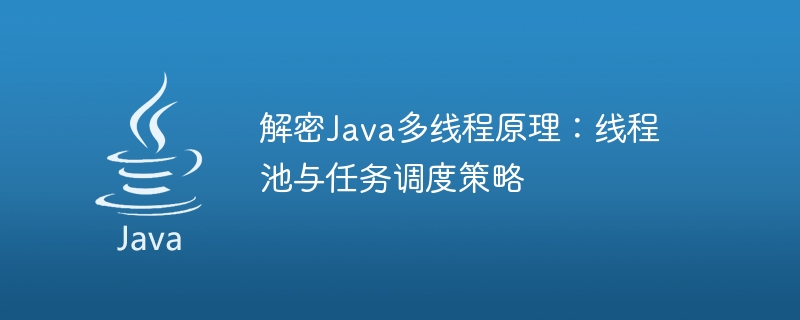Home >Java >javaTutorial >Demystifying Java Multithreading: Deeply Understand the Principles of Thread Pools and Task Scheduling
Demystifying Java Multithreading: Deeply Understand the Principles of Thread Pools and Task Scheduling
- WBOYWBOYWBOYWBOYWBOYWBOYWBOYWBOYWBOYWBOYWBOYWBOYWBOriginal
- 2024-02-19 14:55:06870browse

Decrypting Java multi-threading principles: thread pool and task scheduling strategy
In daily software development, we often need to deal with high concurrency situations, and using multi-threading has become a A common solution. In Java, thread pools and task scheduling strategies have become important tools for multi-threaded programming. This article will decipher the use of thread pools and task scheduling strategies in Java multi-threading principles in detail, and provide specific code examples.
1. The concept and role of thread pool
Thread pool is a mechanism for reusing threads, which can share threads between multiple tasks to improve program performance. Java provides the java.util.concurrent package to implement thread pools. By using a thread pool, you can effectively manage the creation and destruction of threads and avoid the performance overhead caused by frequent thread creation and destruction operations.
In Java, the main functions of the thread pool are as follows:
- Improve performance: the thread pool can reuse threads, avoiding the overhead of frequently creating and destroying threads, thus Improved program performance.
- Control resource occupancy: The thread pool can limit the number of threads to prevent a large number of threads from occupying too many system resources.
- Provide task queue: the thread pool can receive and manage tasks, and store and schedule the execution of tasks through the task queue.
2. Basic use of thread pool
The thread pool in Java is mainly implemented by the classes Executor, ExecutorService and ThreadPoolExecutor. The following is a simple thread pool example that details the basic usage of the thread pool:
import java.util.concurrent.ExecutorService;
import java.util.concurrent.Executors;
public class ThreadPoolExample {
public static void main(String[] args) {
// 创建一个线程池,最多同时运行两个线程
ExecutorService executor = Executors.newFixedThreadPool(2);
// 提交任务到线程池
for (int i = 0; i < 5; i++) {
final int taskId = i;
executor.submit(new Runnable() {
public void run() {
System.out.println("Task " + taskId + " is running in thread " + Thread.currentThread().getName());
try {
Thread.sleep(1000);
} catch (InterruptedException e) {
e.printStackTrace();
}
System.out.println("Task " + taskId + " is completed");
}
});
}
// 关闭线程池
executor.shutdown();
}
}In the above code, a thread pool that can run up to two threads at the same time is first created through the newFixedThreadPool method of the Executors class. Then submit the task to the thread pool for execution through the executor.submit method. Finally, call the executor.shutdown method to close the thread pool.
3. Task Scheduling Strategy
In actual development, we may need to control the scheduling method of tasks more flexibly. Java thread pool provides some built-in task scheduling strategies, such as: FixedThreadPool, CachedThreadPool, ScheduledThreadPool, etc. We can choose an appropriate task scheduling strategy based on actual needs.
- FixedThreadPool: Thread pool with fixed number of threads. The number of threads is fixed. When a new task is submitted, if there are idle threads in the thread pool, it will be executed immediately; if there are no idle threads, the task will be put into the waiting queue.
- CachedThreadPool: Cacheable thread pool. The number of threads is dynamically adjusted as needed. When a new task is submitted, if there are idle threads in the thread pool, it will be executed immediately; if there are no idle threads, a new thread will be created to execute the task. If a thread is idle for a period of time, it will be destroyed to release system resources.
- ScheduledThreadPool: Scheduleable thread pool. Suitable for scenarios where tasks need to be performed regularly. Periodic task execution can be achieved through the scheduleAtFixedRate method.
The following is a sample code using ScheduledThreadPool:
import java.util.concurrent.Executors;
import java.util.concurrent.ScheduledExecutorService;
import java.util.concurrent.TimeUnit;
public class ScheduledThreadPoolExample {
public static void main(String[] args) {
// 创建一个可调度的线程池
ScheduledExecutorService executor = Executors.newScheduledThreadPool(2);
// 周期性执行任务
executor.scheduleAtFixedRate(new Runnable() {
public void run() {
System.out.println("Task is running in thread " + Thread.currentThread().getName());
}
}, 0, 1, TimeUnit.SECONDS);
// 关闭线程池
executor.shutdown();
}
}In the above code, a schedulable thread pool is created through the newScheduledThreadPool method of the Executors class, where parameter 2 represents the thread pool. The number of threads in . Then execute the task periodically through the executor.scheduleAtFixedRate method. Finally, call the executor.shutdown method to close the thread pool.
Summary:
This article introduces in detail the principles and usage of thread pools and task scheduling strategies in Java multi-threaded programming, and provides specific code examples. By using thread pools and flexibly choosing appropriate task scheduling strategies, threads can be better managed and the performance and reliability of the system can be improved. I hope that readers can have a deeper understanding and mastery of Java multi-threaded programming through the introduction of this article.
The above is the detailed content of Demystifying Java Multithreading: Deeply Understand the Principles of Thread Pools and Task Scheduling. For more information, please follow other related articles on the PHP Chinese website!
Related articles
See more- Learning and using Java thread pool principles (picture)
- Detailed explanation of the difference between Thread and runnable in Java multithreading
- A brief overview of java multithreading
- Let's talk about the thread safety issues of Java multithreading
- Concurrent programming skills and application practice of Java thread pool

